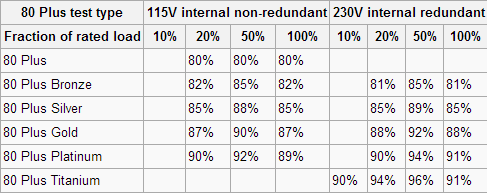FSP Twins 500W Redundant ATX Power Supply Review
Peter Donnell / 8 years ago
Efficiency, PFC and Voltage Regulation
Voltage Regulation
To test voltage regulation we load the power supply to five different load scenarios that give an equal spread of load across every single rail. So that means 20% on all rails, 40% on all rails and so on. We then calculate the average deviance of each rail from its expected voltage.

Voltage regulation isn’t great, but it’s far from bad too. It could be tighter on the 5v and 3v lines, but I can’t see it being a problem. Overall, it’s pretty good for such a compact PSU design; keeping in mind this is 2 x PSUs in one.
Power Efficiency
Power efficiency is measured by calculating actual supplied wattage divided by the wattage drawn at the wall/plug, multiplied by 100 to give a percentage. We then compare that to the particular 80 Plus certification the company claims to see if it meets that. You can see the 80 Plus certifications below, we always test 230v power supplies.


From our testing, we can see that the FSP Twins performance pretty well here. It just scrapes into the 80 Plus Gold section, and while I would have loved for it to do a little better, it’s more efficient than I would have expected given the SFF design of each unit.
Power Factor Correction
Power Factor Correction is the ratio of the real power flowing to the load, to the apparent power in the circuit. The aim of PFC is to make the load circuitry that is power factor corrected appear purely resistive (apparent power equal to real power). In this case, the voltage and current are in phase and the reactive power consumption is zero. The closer the number to one the better as this allows the most efficient delivery of electrical power (Source – Wikipedia).

PFC was very much on point here, rock solid results that are close to perfect for most load scenarios.



















